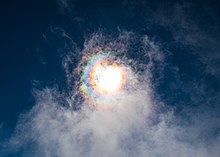

In meteorology, a corona (plural coronae) is an optical phenomenon produced by the diffraction of sunlight or moonlight (or, occasionally, bright starlight or planetlight)[1] by individual small water droplets and sometimes tiny ice crystals of a cloud or on a foggy glass surface. In its full form, a corona consists of several concentric, pastel-colored rings around the celestial object and a central bright area called an aureole.[2][3] The aureole is often (especially in case of the Moon) the only visible part of the corona and has the appearance of a bluish-white disk which fades to reddish-brown towards the edge. The angular diameter of a corona depends on the sizes of the water droplets involved; smaller droplets produce larger coronae. For the same reason, the corona is the most pronounced when the size of the droplets is most uniform. Coronae differ from halos in that the latter are formed by refraction (rather than diffraction) from comparatively large rather than small ice crystals.
The diffraction pattern of the corona resembles an Airy disk, although the underlying physical mechanisms are quite different.
- ^ Cowley, Les (2012). "Jupiter corona from Iran". Atmospheric Optics. Retrieved 2016-05-02.
- ^ Calvert, J. B. (2 August 2003). "The Corona". University of Denver. Retrieved 2017-02-11.
- ^ Cowley, Les. "Corona". Atmospheric Optics. Retrieved 2017-02-11.